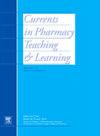Experience using a state board of pharmacy adequate staffing form: A descriptive report
IF 1.4
Q3 EDUCATION, SCIENTIFIC DISCIPLINES
引用次数: 0
Abstract
Background
Between 30 and 50 % of all medication errors may be attributable to inadequate pharmacy staffing. Potentially understaffed pharmacies have garnered national media attention and fostered workforce crises. As such, Boards of Pharmacy (BOPs) have codified laws requiring pharmacists to document inadequate staffing events. Thus, a need exists to prepare students for pharmacy workplace phenomena.
Educational activity
The purpose of this report was to describe two educational activities using the Oklahoma BOP adequate staffing report form. Third-year student pharmacists enrolled in a required, skills-based course completed two formative activities, a knowledge quiz and written assignment, developed from a BOP adequate staffing report form.
Evaluation findings
Forty-one students were enrolled and completed the quiz, and thirty-six completed the staffing report form (87.8 % completion). Mean (standard deviation) scores on the quiz and form were 78.8 % (14.9) and 81.7 % (18.7), respectively. On the quiz, 83 % and 88 % of students achieved low taxonomy learning objectives recalling medication errors and identifying required reporting elements, respectively; however, 65 % of students achieved a high taxonomy objective to document required information. On the written assignment, over 90 % of students provided suggestions to prevent recurrent inadequate staffing, whereas 30 % of students neglected including sufficient summaries of events surrounding an inadequate staffing scenario.
Analysis of educational activity
Over 80 % of student pharmacists recalled and identified necessary information to include on a BOP staffing form, though only 65 % achieved high taxonomy objectives tagged to form completion. Findings of this work suggest that further efforts are needed to prepare and assess student pharmacists' acumen concerning the characteristics and events surrounding inadequately staffed pharmacies, and also their readiness to respond to these environments. Ongoing research should continue to quantify the extent and impact of staffing levels to optimize resources required to improve both patient safety and outcomes and to provide evidence-based guidance for regulatory measures and public policy.
使用州药房委员会适当人员配置表的经验:一份描述性报告
背景:30%到50%的用药错误可归因于药房人员配备不足。可能人手不足的药店引起了全国媒体的关注,并引发了劳动力危机。因此,药学委员会(BOPs)已编纂法律,要求药剂师记录人员配备不足的事件。因此,有必要为学生准备药房工作场所的现象。教育活动本报告的目的是使用俄克拉何马州防喷器适当人员配备报告表描述两项教育活动。参加必修技能课程的三年级学生药剂师完成了两项形成性活动,一项知识测验和书面作业,这些活动由BOP适当人员配备报告表开发。评估结果41名学生被录取并完成了测试,36名学生完成了人员配备报告表(完成率为87.8%)。测验和表格的平均(标准差)分数分别为78.8%(14.9)和81.7%(18.7)。在测试中,分别有83%和88%的学生达到了低分类学习目标,分别是回忆药物错误和识别必要的报告要素;然而,65%的学生达到了记录所需信息的高分类目标。在书面作业中,超过90%的学生提出了防止人员不足的建议,而30%的学生忽视了关于人员不足情况的充分总结。教育活动的分析超过80%的学生药剂师回忆和识别必要的信息,包括在BOP人员配置表中,尽管只有65%的学生达到了高分类目标,标记为完成表格。这项工作的发现表明,需要进一步的努力来准备和评估学生药剂师对药房人手不足的特点和事件的敏锐性,以及他们对这些环境的反应准备。正在进行的研究应继续量化人员配备水平的程度和影响,以优化改善患者安全和结果所需的资源,并为监管措施和公共政策提供循证指导。
本文章由计算机程序翻译,如有差异,请以英文原文为准。
求助全文
约1分钟内获得全文
求助全文
来源期刊

Currents in Pharmacy Teaching and Learning
EDUCATION, SCIENTIFIC DISCIPLINES-
CiteScore
2.10
自引率
16.70%
发文量
192
 求助内容:
求助内容: 应助结果提醒方式:
应助结果提醒方式:


